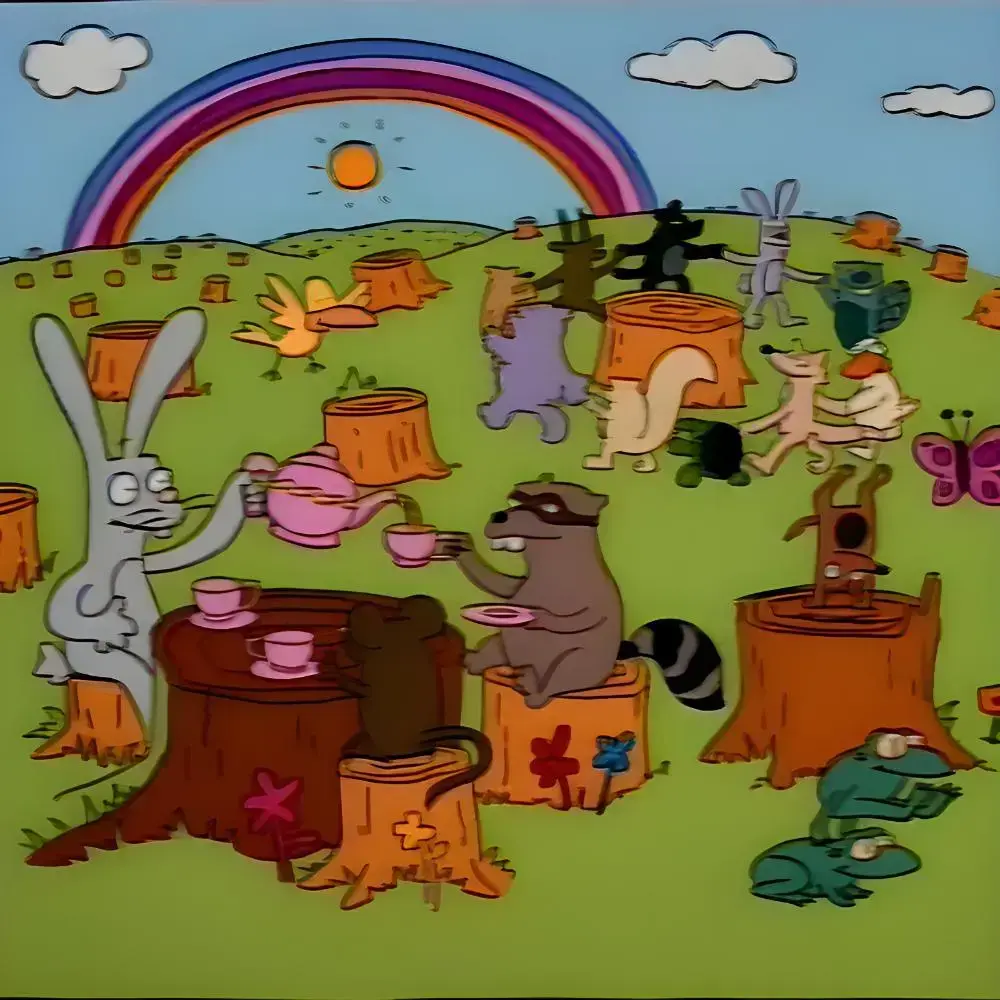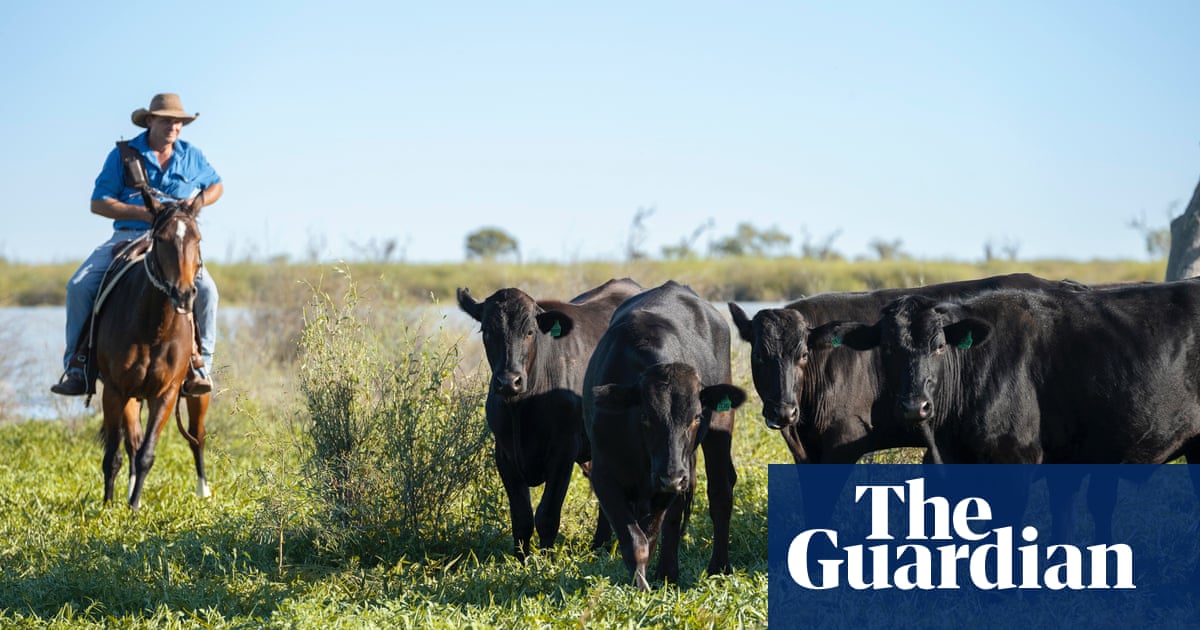- cross-posted to:
- climate@slrpnk.net
- cross-posted to:
- climate@slrpnk.net
One of the world’s longest commercial trials of a seaweed supplement that the global meat industry hopes could slash methane from beef cattle has recorded much lower reductions in the potent greenhouse gas than previous studies.
Putting the supplement into the diets of 40 wagyu cattle in an Australian feedlot for 300 days cut the methane they produced by 28%. The supplement was derived from the red seaweed species Asparagopsis, which has been widely promoted as being able to cut methane by more than 80%, with some experiments suggesting reductions as high as 96%. Globally, the UN’s Food and Agriculture Organization estimates, methane from burping cattle - known as enteric emissions - releases about 2.1bn tonnes of CO2-equivalent a year, compared with the 37.5bn tonnes of CO2 from burning fossil fuels.
Because methane is about 80 times more potent than CO2 at warming the planet over a 20-year period, cutting methane is seen as a way to slow global heating faster.
The trial report noted that other experiments over shorter timeframes using the same open-air measurement technique had recorded higher methane reductions.
The latest trial was financially backed by the country’s biggest beef producer, the Australian Agricultural Company, which helped run the trial and provided the animals.
It’s sucks these results weren’t what was hoped. I remember reading an article from the CSIRO years ago suggesting this to be a good method to reduce emissions from cattle. I can’t remember what percentage reductions of emissions they claimed though.
At this point I’m thinking this idea could be similar to carbon capture storage, in the sense that the idea was taken up as a means of greenwashing for the beef industry, so they could continue to grow while ‘reducing their emissions’.
I guess 28% is still better than nothing, presuming it isn’t used as an excuse for further growth.
Part of the article detailed some earlier claims with one, from memory, being in the high 90’s.
It is a shame but if we could imagine kelp farming off the coast with a cyclic system that brings nutrients back inland with some converted to biochar and fed to the cows for greater methane reduction then maybe it’s a system that would work regeneratively.
Or get rid of most of the cows and do that anyway with better results.
Sorry for the delayed response.
Could you give me a eli5 on biochar? I’ve noticed you refer to it in some other posts/comments, including the fire pits story. I’m guessing char stands for charcoal? If that is the case, how does biochar differ from other charcoals.
Also, how is the kelp related to the biochar?
I mean I guess I could google it, but you seem to have a bit of insight to the whole thing that could help one get an understanding.
In the list of carbon (CO2) drawdown techniques that are available to the human race (IPCC reports), biochar is one of them. It’s the burning of organic matter in the absence of oxygen (pyrolysis) which turns it into straight carbon (the recovery rate is about 20% which makes it carbon positive, mulch is in single digits recovery like near 1%, and soil carbon is high if it’s at 5%). It’s not like cooking charcoal which is a fuel due to the leftover oils and carbon, this is a more inert form of pure carbon (simple explanation).
The bio in bio charcoal is the process of adding to biological processes which function as a home for bacteria (look at electron microscope of good biochar) and an organic coating forms over the surface. When added to soil, it tends to slowly improve the growing of plants and soil life plus water holding, thereby helping store more carbon than is actually present in the biochar itself.
It relates to kelp in the theory that we start farming kelp forests as it’s one of the fastest growing plants, high in micronutrients, recovering some of the nutrients that we lose due to soil erosion and poor agricultural practices and water management. It was theorised that pyrolysis machines could be built on water converting some of the farmed seaweed directly into char and dumping it back overboard, for one example, which would store carbon indefinitely in the ocean. But, we can feed it to cows, it can function in animal bedding, water filtration, composting processes, landfill, building etc. https://www.abc.net.au/news/rural/2019-10-18/wa-farmer-uses-beetles-and-charcoal-to-combat-climate-change/11613846
Biochar doesn’t break down like organic matter, it’s “locked up” carbon (like oil and coal was) and will persist in soil for hundreds to thousands of years.
It seems crazy to burn something to be green, but the technique creates a stable carbon. Decay, the sun, and other processes keep all organic carbon unstable and flowing through the system (forests temporarily hold it for one example, how long depends on health of forest). Biochar takes it out of that.
And the amazing thing is that most methods need huge scale political change, while most people can make biochar in a hole in the ground in the simplest sense. While it’s next to nothing, it’s something on the individual level.
I’m just going to see if this works @Wiggles@aussie.zone . I’ve never seen what an AI says about biochar.
Can you give me an ELI5 about biochar and how it relates to carbon capture and storage.
Absolutely, happy to share about biochar!
Biochar is a type of charcoal that is produced by burning organic material from agricultural and forestry wastes (also known as biomass) in a controlled process called pyrolysis.
Now, how does it relate to carbon capture and storage?
-
Carbon Capture: When plants grow, they absorb CO2 from the atmosphere. As some of the plant’s carbon is in its organic material, when we turn this into biochar, we essentially capture and “lock” this carbon into a stable form that doesn’t easily degrade back into CO2.
-
Carbon Storage: The biochar, which is rich in carbon, can be added to soil. In the soil, biochar can remain stable for hundreds to thousands of years, thereby effectively storing the captured carbon underground, reducing the amount of CO2 released into the environment.
So, overall, biochar presents a method of managing carbon by not only sequestering it on a centuries-long basis, but it offers other benefits like improving soil fertility and increasing agricultural productivity.
This is of course a simplified explanation, and the actual processes and outcomes can be more complex and differ based on various factors like the feedstock used, the pyrolysis process conditions, and the manner in which the biochar is used. But that’s the gist of it!
-
Thanks for the responses, its interesting stuff and seems like a sensible way of trying to reduce emissions and actually capture carbon from the atmosphere.
It makes me think of research that shows that it would make more sense to try and capture carbon from the ocean rather than the atmosphere, as the concentrations are much higher than in the ocean. If we can do this using the natural process of photosynthesis via kelp farms and bio char it could be a very sustainable process.
"THE ocean is the single biggest carbon storage device on Earth,” said Chengxiang ‘CX’ Xiang, CTO and co-founder of direct ocean capture (DOC) company Captura. About 30% of anthropogenic CO2 emissions are absorbed by the ocean, where it is 150 times more concentrated volumetrically than in the air.
He said one of the challenges of removing CO2 directly from air is the “really, really, really low” concentration, prompting the need to build large machinery to filter a lot of air. “Leveraging the ocean to do CO2 drawdown for us as we remove CO2 from the ocean water is a unique process that is inherently scalable.”
This is the source I got that quote from: https://www.thechemicalengineer.com/features/co2-capture-putting-the-sea-into-ccs/
It goes on to talk about how they are working to create tech to capture the carbon, but utilising natural process to achieve the same outcome would be considerably better, though we may need to employ all reasonable methods to decarbonise as quickly as possible.
Interesting reply!
Yeah, it’s just one tiny fraction of a piece of the puzzle (and I dont really hold much hope for us engineering out of this one). We are going to have to do absolutely everything but we can’t even stop land clearing or topsoil erosion.
Kelp farming could end up using exotic species just to increase survivability in the water, all our systems aren’t going to adapt fast enough to the changes coming. If we had our time again, nice train lanes from kelp farming ports to cycle lost nutrients back onto the land maybe could have created some sort of utopia of rich terrestrial systems with abundant marine resources close to shore.
Back to the article, 28% is something, topped up with some biochar, topped up with bacterial implants or something similar would have been nice. Really, the only answer is those things with about 0.5% of the cows. I can see cows being regenerative in some ways to manage some grasslands back into forested systems. The problem is a lot of our grass species aren’t even native, they are selected for production which means management is key.




